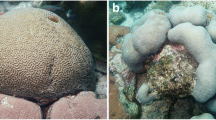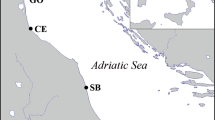Abstract
Pedum spondyloideum is a byssally attached scallop in the Indo-Pacific that lives in deep fan-shaped dwellings within live scleractinian and hydrozoan corals, with the ventral edges of the scallops’ valves protruding slightly from the dwellings. Juvenile scallops have rounded, oval shells and live in shallow depressions. Complete scallop dwellings are formed by the growth of the host and allometric growth of the scallop, and by chemical and physical interactions between the scallop and its host. Scallops were extracted intact from their dwellings within massive corals in the genus Porites in Thailand (7°36′32″ N, 98°21′55″ E; in May 2019) and Malaysia (2°45′17″ N, 104°13′30″ E; in November 2019) to examine the relationship between shell height (SH) and shell width (SW). The slope of the regression of SH on SW within the first 2 years of settlement was 0.79–0.9, indicating that SW increased slightly faster than SH during this period. As the scallop grew further, the slope of the SH on SW was 1.29–1.54, indicating that SH increased faster than SW. A histological study on scallop pallial tissue, including the tentacles, and SEM observations of the dwelling walls suggested that the scallop has secretions that damage coral tissue and widen the dwelling during growth. Thus, the distinctive fan-shaped dwellings of the adult scallops are caused by a combination of allometric scallop growth and erosion of the host tissue and dwelling walls.







Similar content being viewed by others
Data availability
Raw data used in the present study will be supplied upon request.
References
Anderson DT (1992) Structure, function and phylogeny of coral-inhabiting barnacles (Cirripedia, Balanoidea). Zool J Linn Soc 106:277–339
Anderson DT (1994) Barnacles: structure, function, development and evolution. Chapman & Hall, London
Chan BKK, Wong KJH, Cheng YR (2020) Biogeography and host usage of coral-associated crustaceans - barnacles, copepods and gall crabs as model organisms. In: Thiel M, Poore G (eds) The natural history of the crustacea, vol 8. Evolution and biogeography of the crustacea. Oxford University Press, New York, pp 183–215
Clarke KR (1993) Non-parametric multivariate analyses of changes in community structure. Aust J Ecol 18:117–143
DeVantier LM, Endean R (1988) The scallop Pedum spondyloideum mitigates the effects of Acanthaster planci predation on the host coral Porites: host defence facilitated by exaptation. Mar Ecol Prog Ser 47:293–301
Dijkstra HH (2012) Pectinoidea (Bivalvia: Propeamussiidae and Pectinidae) from the Panglao region, Philippine Islands. Vita Malacol 10:1–108
Dijkstra HH, Beu AG (2018) Living scallops of Australia and adjacent waters (Mollusca: Bivalvia: Pectinoidea: Propeamussiidae, Cyclochlamydidae and Pectinidae). Rec Aust Mus 70:113–330
Dojiri M (1988) Isomolgus desmotes, new genus, new species (Lichomolgidae), a gallicolous Poecilostome copepod from the scleractinian coral Seriatopora hystrix Dana in Indonesia, with a review of gall- inhabiting crustaceans of anthozoans. J Crustacean Biol 8:99–109
Goldberg WM (2013) Biology of reefs and reef organisms. The University of Chicago Press, Chicago
Jaccarini V, Bannister WH, Micallef H (1968) The pallial glands and rock boring in Lithophaga lithophaga (Lamellibranchia, Mytilidae). J Zool 154:397–401
Hiro F (1935) A study of cirripeds associated with corals occurring in Tanabe Bay. Rec Oceanogr Wks Jpn 7(1):1–28
Hiro F (1937) Studies on the animals inhabiting reef corals. I. Hapalocarcinus and Cryptochirus. Palao Trop Biol Stn Stud 1:137–154
Kiernan JA (2008) Histological and histochemical methods: theory and practice, 4th edn. Bloxham, London
Kleemann K (1990) Coral associations, biocorrosion, and space competition in Pedum spondyloideum (Gmelin) (Pectinacea, Bivalvia). Mar Ecol 11:77–94
Kleemann K (1995) Associations of coral and boring bivalves: Lizard Island (Great Barrier Reef, Australia) versus Safaga (N Red Sea). Beitr Paläont 20:31–39
Kleemann K (2001) The pectinid bivalve Pedum spondyloideum (Gmelin, 1791): amount of surface and volume occupied in host corals from the Red Sea. Mar Ecol 22:111–133
Morton B, Scott PJB (1980) Morphological and functional specializations of the shell, musculature and pallial glands in the Lithophaginae (Mollusca: Bivalvia). J Zool 192:179–203
Morton B, Scott PJB (1988) Evidence for chemical boring in Petricola lapicida (Gmelin, 1791) (Bivalvia: Petricolidae). J Mol Stud 54:231–237
Nielsen C (1986) Fauna associated with the coral Porites from Phuket, Thailand. Part 1: Bivalves with description of a new species of Gatrochaena. Phuket Mar Biol Cent Res Bull 42:1–24
Nishi E, Nishihira M (1999) Use of animal density banding to estimate longevity of infauna of massive corals. Fish Sci 65(1):48–56
Potts FA (1915) Hapalocarcinus, the gall - forming crab, with some notes on the related genus Cryptochirus. Pap Tortugas Lab Carnegie Inst Wash 8:33–69
Quoy JRC, Gaimard JP (1835) Voyage de découvertes de l’Astrolabe exécuté par ordre du Roi, pendant les années 1826–1827–1828–1829, sous la commandement de M. J. Dumond d’Urville. Zoologie 3(2):369–954 (pls. 1–8)
Roberts CM, McClean CJ, Veron JEN, Hawkins JP, Allen GR, McAllister DE, Mittermeier CG, Schueler FW, Spalding M, Wells F, Vynne C, Werner TB (2002) Marine biodiversity hotspots and conservation priorities for tropical reefs. Science 295:1280–1284
Savazzi E (1998) Constructional morphology of the bivalve Pedum. In: Johnston PA, Haggart JW (eds) Bivalves: an eon of evolution. Paleontological studies honouring Norman D. Newell. Calgary University Press, Calgary, pp 413–421
Scaps P (2009) New associations between the scallop Pedum spondyloideum (Bivalvia, Pteriomorphia: Pectiniidae) and scleractinian corals from the north eastern coast of Borneo (Malaysia). Zool Stud 48:492
Scaps P (2011) Associations between the scallop Pedum spondyloideum (Bivalvia, Pteriomorphia, Pectiniidae) and hard corals on the West coast of Thailand (north Andaman Sea). Zool Stud 50:466–474
Scaps P (2020) Association between the scallop Pedum spondyloideum (Bivalvia: Pteriomorphia: Pectinidae) and scleractinian corals from Nosy Be, Madagascar. Cah Biol Mar 6:73–80. https://doi.org/10.21411/CBM.A.E9AF1222
Scaps P, Denis V (2007) Association between the scallop Pedum spondyloideum (Bivalvia, Pteriomorphia, Pectinidae) and scleractinian corals from the Wakatobi Marine National Park (SE Sulawesi, Indonesia). Raffles B Zool 55(2):1–10
Scaps P, Denis V (2008) Comparison of associations between the pectinid bivalve Pedum spondyloideum (Bivalvia, Pteriomorphia, Pectinidae) and scleractinian hermatypic corals in the Red Sea and the West Pacific Ocean. Bull Soc Zool France 133(1–3):43–54
Scaps P, Denis V, Berhimpon S, Kaligis F (2005) Coral associations and space competitors of Pedum spondyloideum (Gmelin, 1791) (Bivalvia, Pteriomorphia: Pectiniidae) from the northeast coast of Sulawesi. Basteria 69:157–166
Scaps P, Denis V, Berhimpon S (2008) Comparison of the associations between the pectinid bivalve Pedum spondyloideum (Bivalvia, Pteriomorphia: Pectiniidae) and scleractinian hermatypic corals in the Red Sea and the West Pacific Ocean. Bull Soc Zool France 133:39–50
Shima JS, Osenberg CW, Stier AC (2010) The vermetid gastropod Dendropoma maximum reduces coral growth and survival. Biol Lett. https://doi.org/10.1098/rsbl.2010.0291
Tanzil JT, Brown BE, Tudhope AW, Dunne RP (2009) Decline in skeletal growth of the coral Porites lutea from the Andaman Sea, South Thailand between 1984 and 2005. Coral Reefs. https://doi.org/10.1007/s00338-008-0457-5
Tanzil JT, Brown BE, Dunne RP, Lee JN, Kaandorp JA, Todd PA (2013) Regional decline in growth rates of massive Porites corals in Southeast Asia. Glob Change Biol 19(10):3011–3023. https://doi.org/10.1111/gcb.12279
Van Tienderen KM, Van der Meij SET (2016) Occurrence patterns of coral-dwelling gall crabs (Cryptochiridae) over depth intervals in the Caribbean. PeerJ. https://doi.org/10.7717/peerj.1794
Waller TR (1972) The Pectinidae (Mollusca: Bivalvia) of Eniwetok Atoll Marshall Islands. The Veliger 14(3):221–264
Yonge CM (1967) Observations on Pedum spondyloideum (Chemnitz) Gmelin, a scallop associated with reef-building corals. Proc Malacol Soc Lond 37:311–323
Acknowledgements
This work was supported by a King Mongkut’s Institute of Technology Ladkrabang Research Fund (Academic Melting Pot Programme Grant no. KREF206216) and Senior Investigator Award, Academia Sinica, Taiwan (AS-IA-105-L03). The authors would like to acknowledge the research collection permit from the Research Promotion and Co-ordination Committee, Ministry of Economic Affairs (MEA) of the Malaysian Government UPE/40/200/19/3463(20). Thanks to Wei-Peng Hsieh (Academia Sinica) for assisting with histological sectioning and Noah Last of the Third Draft Editing Company for his English editing. Thanks also to two reviewers for providing constructive comments to further improve the quality of our work.
Author information
Authors and Affiliations
Contributions
BKKC, JCHT, MG initiated the study, conducted the sampling and data analysis and wrote the MS.
Corresponding author
Ethics declarations
Conflict of interest
All authors have no conflict of interest.
Ethical approval
All sampling in Thailand was outside marine protected areas and no permit was required. Sampling in Malaysia was conducted under a research collection permit from the Research Promotion and Coordination Committee, Ministry of Economic Affairs (MEA) (UPE/40/200/19/3463(20)) and Department of Fisheries Malaysia (Prk.ML.630-7 (41)) of the Malaysia Government.
Additional information
Responsible Editor: J. Grassle.
Publisher's Note
Springer Nature remains neutral with regard to jurisdictional claims in published maps and institutional affiliations.
Reviewed by P. Scaps and an undisclosed expert.
Electronic supplementary material
Below is the link to the electronic supplementary material.
Fig. S1
Parameters measured for multivariate and regression analysis in adult and juvenile shells (TIF 17825 kb)
Rights and permissions
About this article
Cite this article
Chan, B.K.K., Tan, J.C.H. & Ganmanee, M. Living in a growing host: growth pattern and dwelling formation of the scallop Pedum spondyloideum in massive Porites spp. corals. Mar Biol 167, 95 (2020). https://doi.org/10.1007/s00227-020-03716-8
Received:
Accepted:
Published:
DOI: https://doi.org/10.1007/s00227-020-03716-8




